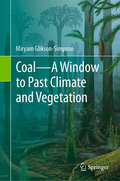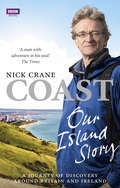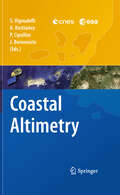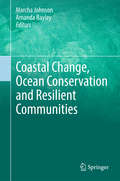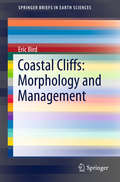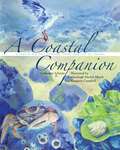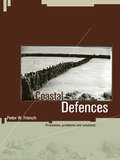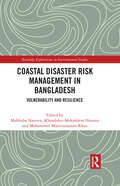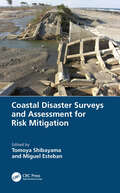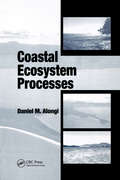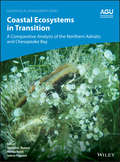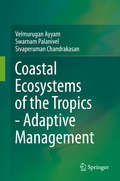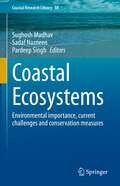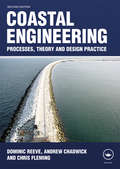- Table View
- List View
Coal—A Window to Past Climate and Vegetation
by Miryam Glikson-SimpsonThis book focuses on the Permian time slice in the geological history of Gondwana, which includes Australia, India, South Africa, Antarctica and South America. Coal is an organic rock, the product of compressed and ‘cooked’ plants. The exact formation of coal via physicochemical reactions, burial and subsidence is the subject of numerous books. The vast thick coal deposits characterising Gondwana formed from special kind of trees termed the Glossopteris Flora. These trees shed their leaves in winter and with the rest of their remains decayed and through subsidence and burial formed the coal. Pollen preserved from these plant communities has been concentrated and isolated and is the focus of this book. The first plant communities as can be seen from the pollen graphs in this book were impoverished in species. The Permian era started with a very cold climate and as the climate warmed more and more diverse vegetation took hold. The emergence of different forms of pollen at certain times in the Permian is used as an indicator of climatic change. Furthermore, the predominance of algal spores in some samples and lack of representation by pollen of Glossopteris point to significant changes in the climate which led to the disappearance of their pollen and the accumulation of spores representing algal communities. These climate induced changes are noticed in their completed transformation after a long time span; small changes are evident during a lifetime of Earth’s inhabitants. Today, in our lifetime, we can see and witness the drying of many lakes across the Earth and their total disappearance from maps of only 50 years ago is a testimony to a climatic change taking place. The time of a ‘complete’ change in the Permian is possible to calculate. However, to determine the duration and maximum change in the climate of the earth today is impossible due to the apparent acceleration of the process by industrial activities of our species. Chapter 4 in the book deals with the special characteristics of the Permian coals of Gondwana and the special plant community which made them. The composition of these coals on a microscopic level shows them to be rich in hydrocarbons, more than other coals. The Permian coals of India and Australia generate ‘heavy’ oil which is retained within the coal matrix as bitumen and is a potential source of methane. This chapter demonstrates through a pilot study the potential for explosion in the Permian Gondwana coals through their propensity to spontaneous combustion and methane generation.
Coast: A Journey of Discovery Around Britain's Coastline
by Nicholas CraneAlong our shores, towering cliffs from the age of the dinosaurs rise beside wide estuaries teeming with wildlife, while Victorian ports share waterfronts with imposing fortifications.And the people who have lived, worked and played on this spectacular coast - from Stone Age fishermen to seafarers, chart-makers and surfers - have an incredible tale to tell.Coast: Our Island Story is an enthralling account, sparkling with geography, history, adventure and eccentric characters, told with Nick Crane's trademark charisma and wit.
Coastal Altimetry
by Andrey G. Kostianoy Jérôme Benveniste Paolo Cipollini Stefano VignudelliThe book describes experience in application of coastal altimetry to different parts of the World Ocean. It presents the principal problems related to the altimetry derived products in coastal regions of the ocean and ways of their improvement. This publication is based on numerous satellite and observational data collected and analyzed by the authors of the various chapters in the framework of a set of international projects, performed in UK, France, Italy, Denmark, Russia, USA, Mexico and India. The book will contribute both to the ongoing International Altimeter Service effort and to the building of a sustained coastal observing system in the perspective of GMES (Global Monitoring for Environment and Security) and GEOSS (Global Earth Observation System of Systems) initiatives. This book is aimed at specialists concerned with research in the various fields of satellite altimetry, remote sensing, and coastal physical oceanography. The book will be also interesting for lecturers, students and post-graduate students.
Coastal Change, Ocean Conservation and Resilient Communities
by Amanda Bayley Marcha JohnsonThis collection of essays and design case studies explores a range of ideas and best practices for adapting to dynamic waterfront conditions while incorporating nature conservation in urbanized coastal areas. The editors have curated a selection of works contributed by leading practitioners in the fields of coastal science, community resilience, habitat restoration, sustainable landscape architecture and floodplain management. By highlighting ocean-friendly innovations and strategies being applied in coastal cities today, this book illustrates ways to cohabit with many other species who share the waterfront with us, feed in salt marshes, bury their eggs on sandy beaches, fly south over cities along the Atlantic Flyway, or attach themselves to an oyster reef. This book responds to the need for inventive, practical, and straightforward ways to weather a changing climate while being responsible shoreline stewards.
Coastal Cliffs: Morphology and Management (SpringerBriefs in Earth Sciences)
by Eric BirdThis book offers an insight into the global occurrence, geomorphology, evolution, weathering and erosion of coastal cliffs and bluffs. Stabilization and preservation of cliffs are treated in detail. Mitigation of cliff hazards and preservation of scenic features and sites of scientific importance requires effective coastal cliff management that can only be based on thorough knowledge of the physical processes at work. Cliffs have been cut in various geological formations, and have taken shape as a sequel to a world-wide sea level rise. Most cliffs have receded as the result of weathering and erosion, but some are now stable. Where they are actively receding, consuming useful agricultural or forested land or threatening coastal structures such as roads, buildings and seaside towns, it may be necessary to halt their retreat, or at least to modify it, by coastal cliff management.
Coastal Companion: A Year in the Gulf of Maine, from Cape Cod to Canada
by Catherine SchmittA chronicle of changes through the seasons both above and within the sea, A COASTAL COMPANION follows the arrival and departure of migrating shorebirds in spring and fall, schools of fish as they move in and out of our region, and the natural cycles of our bays, rivers, marshes, and coastal forests. Part field guide, part almanac, the book also highlights writers, artists, and scientists who have chosen the Gulf of Maine as their subject matter. Poems by twelve contemporary poets open each chapter, and illustrations by two Maine artists, Kimberleigh Martul-March and Margaret Campbell, are featured throughout the text. This is a book to keep close at hand, to be read not all at once, but through the seasons, one day at a time, and enjoyed year after year.
Coastal Conservation
by Brooke Maslo Julie L. LockwoodCoastal ecosystems are centres of high biological productivity, but their conservation is often threatened by numerous and complex environmental factors. Citing examples from the major littoral habitats worldwide, such as sandy beaches, salt marshes and mangrove swamps, this text characterises the biodiversity of coastline environments and highlights important aspects of their maintenance and preservation, aided by the analysis of key representative species. Leaders in the field provide reviews of the foremost threats to coastal networks, including the effects of climate change, invasive species and major pollution incidents such as oil spills. Further discussion underscores the intricacies of measuring and managing coastline species in the field, taking into account the difficulties in quantifying biodiversity loss due to indirect cascading effects and trophic skew. Synthesising the current state of species richness with present and projected environmental pressures, the book ultimately establishes a research agenda for implementing and improving conservation practices moving forward.
Coastal Defences: Processes, Problems and Solutions
by Peter W. FrenchCoastal Defences aims to present the broad spectrum of methods that engineers use to protect the coastline and investigates the sorts of issues that can arise as a result. The first section of the book examines 'traditional' hard techniques, such as sea walls and groynes, whilst the second looks at the more recent trend of using techniques more sympathetic to nature. By looking at each of the main methods of coastal protection in detail, the book investigates the rationale for using each method and the consequent management issues, presenting a case for and against each of the techniques.
Coastal Disaster Risk Management in Bangladesh: Vulnerability and Resilience (Routledge Explorations in Environmental Studies)
by Mohammed Moniruzzaman Khan Mahbuba Nasreen Khondoker Mokaddem HossainThis book addresses disaster and disaster risk reduction (DRR) practices, constraints and capacity in the context of coastal Bangladesh. Located in the lower riparian of the Bay of Bengal, Bangladesh has to face frequent disasters such as floods, cyclones, river erosion, salinity intrusion as well as drought. Drawing together a range of multidisciplinary perspectives, Coastal Disaster Risk Management in Bangladesh explores the connection between climate change and DRR issues in this region. The editors reorganize disaster studies around social and physical changes that can reduce these risks and put at risk populations on a stronger footing by making risk reduction the focus. These include measures to improve disaster preparedness, to boost recovery by creating better disaster planning and programs, and physical and social initiatives to improve disaster resilience. Also, analyzing the gender perspective, the volume also utilizes the local knowledge framework to consider whether these populations have resilient knowledge that needs to be incorporated into initiatives based on advanced technology and perspectives. This book will be of interest to academics, researchers, students, policymakers and practitioners in the field of disaster, DRR and governance, climate change, climate change adaptation (CCA) and the environment.
Coastal Disaster Surveys and Assessment for Risk Mitigation
by Miguel Esteban Tomoya ShibayamaThis collection covers essential concepts in the management of coastal disasters, outlining several field surveys of such events that have taken place in the 21st century, including the Indian Ocean Tsunami, the Tohoku Earthquake and Tsunami, and the storm surges generated by Hurricane Katrina, Cyclone Nargis, and Typhoon Haiyan. Measurements of flood heights, distributions of structural destruction, and the testimonies of residents are reported, with the results being analysed and compared with past events and numerical simulations to clarify and reconstruct the reality of these disasters. The book covers the state-of-the-art understanding of disaster mechanisms and the most advanced tools for the simulation of future events: • Uniquely explains how to use disaster surveys along with simulations to mitigate risk • Combines pure scientific studies with practical research and proposes procedures for effective coastal disaster mitigation Coastal Disaster Surveys and Assessment for Risk Mitigation is ideal for students in the field of disaster risk management, as well as engineers who deal with issues related to tsunamis, storm surges, high wave attack and coastal erosion.
Coastal Ecosystem Processes
by Daniel M. AlongiCoastal Ecosystem Processes, written by the renowned marine scientist Daniel Alongi, describes how pelagic and benthic food webs, from beaches and tidal flats to the continental edge, process energy and matter. This volume focuses on recent advances and new developments on how food webs are closely intertwined with the geology, chemistry, and physics of coastal seas. Dr. Alongi presents a process-functional approach as a way of understanding how the energetics of coastal ecosystems rely not only on exchanges within and between food chains, but how such functions are influenced by terrigenous and atmospheric processes. There is a need for documentation and an awareness of just how necessary, yet delicate, is the interplay of biological and physical forces between coastal ocean, land, and the atmosphere. Marine scientists today need to make informed management decisions about sustainable development and conservation of these fragile ecosystems. Coastal Ecosystem Processes provides present and future marine scientists the latest coastal ecosystem information to make the right decisions concerning the ecology of our oceans.
Coastal Ecosystems in Transition: A Comparative Analysis of the Northern Adriatic and Chesapeake Bay (Geophysical Monograph Series #256)
by Thomas C. Malone Alenka Malej Jadran FaganeliExplores how two coastal ecosystems are responding to the pressures of human expansion The Northern Adriatic Sea, a continental shelf ecosystem in the Northeast Mediterranean Sea, and the Chesapeake Bay, a major estuary of the mid-Atlantic coast of the United States, are semi-enclosed, river-dominated ecosystems with urbanized watersheds that support extensive industrial agriculture. Coastal Ecosystems in Transition: A Comparative Analysis of the Northern Adriatic and Chesapeake Bay presents an update of a study published two decades ago. Revisiting these two ecosystems provides an opportunity to assess changing anthropogenic pressures in the context of global climate change. The new insights can be used to inform ecosystem-based approaches to sustainable development of coastal environments. Volume highlights include: Effects of nutrient enrichment and climate-driven changes on critical coastal habitats Patterns of stratification and circulation Food web dynamics from phytoplankton to fish Nutrient cycling, water quality, and harmful algal events Causes and consequences of interannual variability The American Geophysical Union promotes discovery in Earth and space science for the benefit of humanity. Its publications disseminate scientific knowledge and provide resources for researchers, students, and professionals.
Coastal Ecosystems of the Tropics - Adaptive Management
by Velmurugan Ayyam Swarnam Palanivel Sivaperuman ChandrakasanThe coastal areas of the tropics are rich in biodiversity, natural resources and place of intensive developmental activities as it provides livelihood to millions of people. At the same time evidences suggest that several unique coastal ecosystems viz., mangroves, wetlands, salt marshes, corals, estuaries, sand dunes and agro-ecosystem are vulnerable to natural disasters and events associated with global climate change. In recent times degradation of land, water and genetic erosion besides threat to native flora and fauna have been increasing due to unsustainable developmental activities. Therefore, a paradigm shift in deriving livelihood through conventional methods, developmental strategies, conservation practices are required for balanced and sustainable growth of the coastal areas. This publication strives to cover the status of different natural resources of the coastal region, various aspects of degradation process, production need and restorative methods besides new technological options and its socio-economic implications with case examples. Special focus is given to bring out the scope and potential of mangrove based farming, integrated and organic farming and its value addition besides the role of coastal vegetations as bioshield in protecting these regions from sea erosion, cyclones and tsunami. As the tropical coastal areas are vulnerable to climate change events, this book also covers the recent weather pattern, impacts of climate change and climate resilient technologies besides intuitional linkages and policy framework aimed at balancing development and environmental concerns.
Coastal Ecosystems: Environmental importance, current challenges and conservation measures (Coastal Research Library #38)
by Pardeep Singh Sughosh Madhav Sadaf NazneenThis volume incorporates theoretical and practical knowledge through case studies and reviews to serve as a baseline of information for coastal ecosystem research, and discusses the impacts of pollution, industrialisation, agriculture and climate change on coastal ecosystem biogeochemistry and biodiversity. The case studies address the role of coastal ecosystems as a carbon sink which is getting impacted by anthropogenic disturbances. Through this analysis, the book covers various strategies for the conservation and management of coastal ecosystems, considering their unique ecological and biogeochemical attributes and region-specific threats and impacts. The book will be of interest to a wide range of readers including students, researchers and professionals in coastal ecosystem science, coastal pollution, climate change adaptation, biodiversity conservation and environmental management.
Coastal Engineering: Processes, Theory and Design Practice
by Andrew Chadwick Dominic Reeve Christopher FlemingHistorically, much harm has been done by well-meaning coastal engineering attempts, which seemed like good ideas on paper but which failed to allow for practical issues. For this reason, it is vital that theories and models are well grounded in practice. This second edition brings the models and examples of practice up to date. It has expanded coverage of tsunamis and generating energy from waves to focus both on the great dangers and the great opportunities that the ocean presents to the coastal zone. With an emphasis on practice and detailed modelling, this is a thorough introduction to all aspects of coastal processes, morphology, and design of coastal defences. It describes numerous case studies to illustrate the successful application of mathematical modelling to real-world practice. A must-have book for engineering students looking to specialize in coastal engineering and management.
Coastal Engineering: Processes, Theory and Design Practice
by Andrew Chadwick Dominic Reeve Christopher FlemingEffective coastal engineering is expensive, but it is not as costly as neglect or ineffective intervention. Good practice needs to be based on sound principles, but theoretical work and modelling also need to be well grounded in practice, which is continuously evolving. Conceptual and detailed design has been advanced by new industry publications since the publication of the second edition. This third edition provides a number of updates: the sections on wave overtopping have been updated to reflect changes brought in with the recently issued EurOtop II manual; a detailed worked example is given of the calculation of extreme wave conditions for design; additional examples have been included on the reliability of structures and probabilistic design; the method for tidal analysis and calculation of amplitudes and phases of harmonic constituents from water level time series has been introduced in a new appendix together with a worked example of harmonic analysis; and a real-life example is included of a design adapting to climate change. This book is especially useful as an information source for undergraduates and engineering MSc students specializing in coastal engineering and management. Readers require a good grounding in basic fluid mechanics or engineering hydraulics, and some familiarity with elementary statistical concepts.
Coastal Environments of India: A Coastal West Bengal Perspective (Springer Water)
by Gautam Kumar DasThis book is the result of comprehensive research work on the various aspects of the West Bengal coast including the world’s largest riverine delta system, the Ganga-Brahmaputra Delta. The role of various hydrodynamic factors in shaping the coastal configuration and physicochemical parameters of coastal waters, soils, and granulometry of beach sands are extensively discussed. The coasts of the Indian peninsula, particularly the east coast, are subjected to severe cyclones, tidal bores, storm surges, and strong drift, which changes the coastal configuration as well as the quality of waters and the fertility of soils. A systematic description of major cyclones and their effects on coastal areas are described in detail. The book offers comprehensive information on the prevailing ecological conditions and lush green mangrove forests with wide-ranging flora and fauna of Sundarbans. UNESCO has declared Sundarbans as one of the world’s heritage sites, and as in other parts of the world, some of the coastal areas in West Bengal have attracted the attention of many tourists. Various steps undertaken by the government for coastal zone management and sustainable development of the coastal areas have been highlighted in the book. This book will be of interest to students and researchers of the coastal environment.
Coastal Environments of India: A Comprehensive Approach
by Anil Kumar Dikshit P. ThambiduraiCoastal environments are unique and highly dynamic ecosystems that play a vital role in climate regulation, support biodiversity, and highly impact human activities. This book deals with a combination of specialized areas in multiple fields. It covers the coastal ecosystem of marine life and its importance for biodiversity conservation. Sincerely addressing significant coastal dynamics, including coastal erosion and sedimentation on the shorelines. Natural hazards that caused widespread damage all along the coastal habitation on a global scale. Further, it evaluates the effects of human activities on coastal development, pollution, and predation on marine ecosystems, besides adding notorious human-induced pollution, which is of great environmental concern now. Importantly, this combination of specializing within an area of multiple fields leads to a broad range of research issues. This book offers numerous components of study to create a comprehensive guide for future prospects.
Coastal Erosion and Protection in Europe: A Comprehensive Overview
by Allan Williams Enzo PranziniEurope has a long history of managing coastal erosion through a variety of protection strategies, from the defences of the Venice lagoons to coastal land reclamation in the Netherlands. This book provides a comprehensive review of the entire coastline of Europe and a comparative analysis of erosion problems and solutions in each country. Each chapter discusses the natural and anthropogenic factors in the erosion process and in defence projects design and maintenance, including coastal morphology and wave climate, land use changes and use of coastal areas, the evolution of coastal protection, climate change and political and administrative assessments. Particular attention is paid to demographic and economic factors influencing coastal erosion in each country and to technical and administrative criteria influencing defence projects design. Lavishly illustrated in full colour throughout, the book represents a definitive reference work on its subject.
Coastal Geology (Springer Textbooks in Earth Sciences, Geography and Environment)
by Juan A. MoralesThis textbook shows all the existing knowledge about coastal geology and its implications for coastal management. In the last decades, the geological sciences have been supplying exciting information about the coastal systems, not only from its dynamics but also providing a sedimentary concept to understand and interpret the preserved coastal stratigraphical record. Furthermore, recent investigations have been focused on the prevention of coastal hazards like storms, tsunamis, or sea-level fluctuation. This discipline has an increasing interest after the expanding human activities around the coasts worldwide. The present trend is that many of the problems raised by the coast–human interaction must be resolved by using the Integrated Coastal Zone Management.The chapters of this book have a double-level structure. The first part of each chapter contains the necessary information for undergraduate courses studying coastal geology. The second part includes advanced information and examples to be used by graduate students and novel professionals.
Coastal Geomorphology
by Eric BirdCoastal Geomorphology, Second Edition is a comprehensive and systematic introduction to this subject and demonstrates the dynamic nature of coastal landforms, providing a background for analytical planning and management strategies in coastal areas that are subject to continuing changes.This introductory textbook has been completely revised and updated, and is accompanied by a website which provides additional illustrations, global examples, case-studies and more detailed and advanced information on topics referenced in the book, together with explanations of terminology, annotated references and research material.
Coastal Geomorphology: Binghamton Geomorphology Symposium 3 (Routledge Library Editions: Geology #5)
by Donald R. CoatesThis book, first published in 1973, presents the papers from the 3rd Binghamton Geomorphology Symposium. The necessity for interdisciplinary cooperation in research on the processes and terrain of the littoral zone is reflected here, and the central theme that emerges from all papers is the dynamic aspect of the coastal environment, and the way geomorphic principles can be used to solve problems.
Coastal Governance (Foundations of Contemporary Environmental Studies)
by Richard BurroughsCoastal Governance provides a clear overview of how U.S. coasts are currently managed and explores new approaches that could make our shores healthier. Drawing on recent national assessments, Professor Richard Burroughs explains why traditional management techniques have ultimately proved inadequate, leading to polluted waters, declining fisheries, and damaged habitat. He then introduces students to governance frameworks that seek to address these shortcomings by considering natural and human systems holistically. The book considers the ability of sector-based management, spatial management, and ecosystem-based management to solve critical environmental problems. Evaluating governance successes and failures, Burroughs covers topics including sewage disposal, dredging, wetlands, watersheds, and fisheries. He shows that at times sector-based management, which focuses on separate, individual uses of the coasts, has been implemented effectively. But he also illustrates examples of conflict, such as the incompatibility of waste disposal and fishing in the same waters. Burroughs assesses spatial and ecosystem-based management's potential to address these conflicts. The book familiarizes students not only with current management techniques but with the policy process. By focusing on policy development, Coastal Governance prepares readers with the knowledge to participate effectively in a governance system that is constantly evolving. This understanding will be critical as students become managers, policymakers, and citizens who shape the future of the coasts.
Coastal Hazards: Hazards, Vulnerability, And Management (Coastal Research Library #6)
by Charles W. FinklThis book covers the gamut of coastal hazards that result from short-term low-frequency events and have high-magnitude and far-reaching impacts on coastal zones the world over. Much of the world's population now lives in low-lying coastal zones that are inherently vulnerable to natural hazards such as flooding from hurricanes, tropical storms and northeastern storm surges; shoreline (beach and dune) erosion; cliff and bluff failures; and saltwater intrusion in coastal aquifers used for drinking water supplies. In addition to the usual range of hydrometeorological disasters in coastal zones, this book covers tsunami impacts and warning systems as well as global perspectives of sea-level rise impacts and human perceptions of potential vulnerabilities resulting from rip currents that cause many drownings each year on beaches. Today, the use of numerical models that help predict vulnerabilities and provide a basis for shore protection measures is important in modern scientific and engineering systems. Final considerations focus on human actions in the form of the urbanization and industrialization of the coast, shore protection measures, and indicate how environmental degradation around coastal conurbations exacerbates the potential for unwanted impacts. Strategies for environmental management in coastal zones, from low-lying wetlands to high cliffs and rocky promontories, are highlighted as a means of living in harmony with Nature and not trying to conquer it.
Coastal Heritage and Cultural Resilience (Ethnobiology)
by Lisa L. Price Nemer E. NarchiThis book explores the knowledge, work and life of Pacific coastal populations from the Pacific Northwest to Panama. Center stage in this volume is the knowledge people acquire on coastal and marine ecosystems. Material and aesthetic benefits from interacting with the environment contribute to the ongoing building of coastal cultures. The contributors are particularly interested in how local knowledge -either recently generated or transmitted along generations- interfaces with science, conservation, policy and artistic expression. Their observations exhibit a wide array of outcomes ranging from resource and human exploitation to the magnification of cultural resilience and coastal heritage. The interdisciplinary nature of ethnobiology allows the chapter authors to have a broad range of freedom when examining their subject matter. They build a multifaceted understanding of coastal heritage through the different lenses offered by the humanities, social sciences, oceanography, fisheries and conservation science and, not surprisingly, the arts. Coastal Heritage and Cultural Resilience establishes an intimate bond between coastal communities and the audience in a time when resilience of coastal life needs to be celebrated and fortified.
